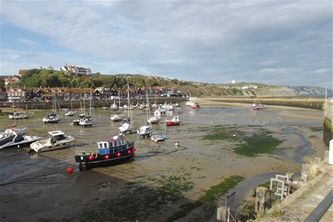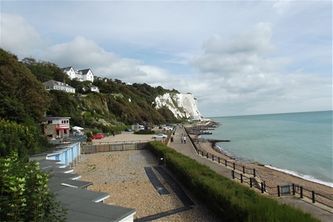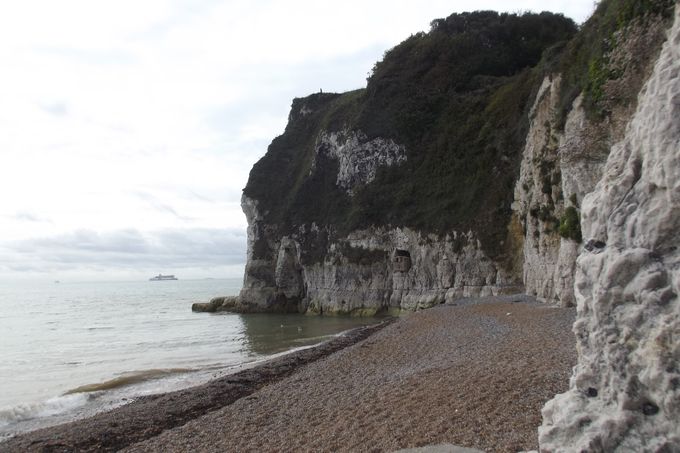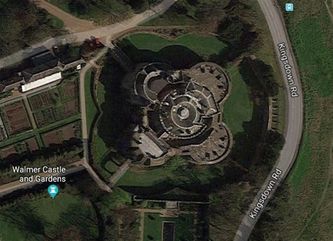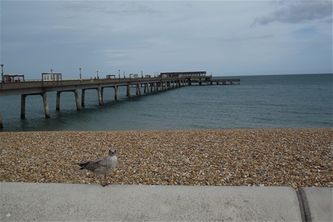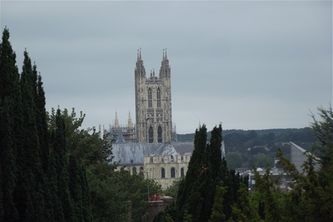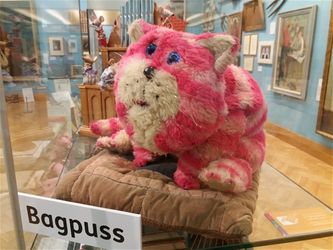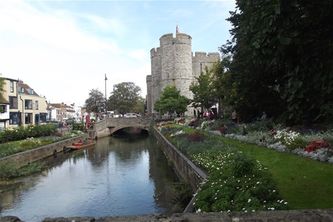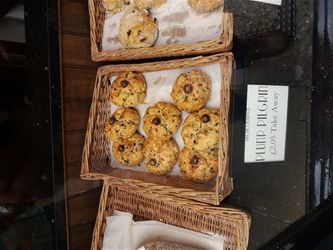The Garden of England
After a sandwich lunch and a wee rest we drove in to Folkestone for a mooch around. Folkestone is definitely a town of two parts. Since the loss of its ferry service the town has gone into a bit of a decline and the main town centre seemed a bit scruffy. However the old port, the old railway Harbour Station and the seafront have been upgraded quite considerably.
We started our visit with a stroll through the Lower Leas park, between the cliffs and the pebbly beach, lots of nice curving pathways through a variety of trees and shrubs, then back through the park and across the beach to the harbour area. The main harbour pier was a hive of activity, with a number of restaurants and pop-up food stores, music playing and crowds enjoying the sunshine. We sat in the sun with an ice cream then took the stairs down to the lower level where there is an Anthony Gormley statue, ‘Another Time’, standing looking at the view across the bay to the white cliffs of Dover. He does not see this view all the time of course, because at high tide he is submerged.
At the landward end of the pier the old Harbour Station has been renovated and is filled with craft and souvenir shops. The old signal box is looking very smart too.
St Margaret's Bay
Monday 10 September
Monday dawned bright and breezy so we drove down to Dover and drove round the town a little before climbing Jubilee Way, the long hill out of town from the ferry port, then along the coast to St Margaret’s Cliffe then the winding road down into St Margaret’s Bay. I brought my Mum here a few years ago, her last trip out before she was confined to a nursing home, because it was here as a child that she spent many school summer holidays with her brother and her cousins. She said then that it was little changed from the 1920’s and 30’s, and it certainly had not changed in the few years since I was there. A very typical south Kent undeveloped resort, small sand and pebble beach backed by white cliffs, a pub, a kiosk and a couple of houses. After a wander we had a coffee at the kiosk watching the ferries in and out of Dover.
Looking towards Dover
Walmer
We drove on along the coast to Walmer Castle, the official residence of the Lord Warden of the Cinque Ports. Built by Henry VIII as a defence against the French it has been occupied by Wardens such as Lord North, Pitt the Younger & the Duke of Wellington. Although having a castle - like exterior, with a round central keep and four large round bastions at each corner, inside it is more of a home, albeit the rooms are all of an odd shape and size to fit the exterior walls. Much of the interior is given over to a museum of Wellington’s life, including, on display, the original Wellington Boots.
Outside are some lovely sheltered gardens and woodland and a large ornamental pond. The moat has been grassed over and provides a nice strolling area. The basement is now a café, with the eating area either there or on an upstairs terrace overlooking the sea and surrounded by cannons. There we ate a very nice sausage baguette.
(Arial view courtesy of Google Maps)
We then drove on to Deal, passing the huge Royal Marine Depot and another castle larger than Walmer but less well maintained. Along the seafront there is a dull concrete pier, which we walked out on, but we were not particularly impressed. The town itself had that common sadness of a resort and port long past its best.
Then it was back to Black Horse Farm to erect the awning and have dinner.
Canterbury Part One
Tuesday 11 September
It was still sunny and warm today so we set off for Canterbury, using the city’s New Dover Road park and ride facility. It was good to see that there were parking spaces set aside for motor homes.
Once in the city we walked down towards the Cathedral and were interested to see lots of young people in gowns, accompanied by proud parents all dressed up. It was Graduation Day, and the Cathedral had been closed for the ceremonies.
Not to worry, there is so much to see in Canterbury we would need a second day anyway. We wandered through the streets and came to the Beaney House of Art and Knowledge, a very interesting museum best described by quoting their website:
“The building takes its name from its benefactor, Dr James George Beaney, a Canterbury-born man of modest background who studied medicine before emigrating to Australia, where he found his success. Upon his death in 1891, Dr Beaney left money in his will to the city of Canterbury to build an ‘Institute for Working Men’ with amenities for men from poor backgrounds such as his own. His patronage was fundamental in building the Beaney Institute: a new home for the Canterbury Royal Museum and Free Library, now known as The Beaney House of Art & Knowledge”.
Before attacking the exhibits we had a coffee in the Beaney Café, where they served locally produced eco friendly fair trade vegetarian and vegan gluten free cakes and drinks in environmentally friendly cups with free wi-fi. What more could you ask for? Yes, they would refill your water bottle free of charge too.
The museum itself was fascinating, all sorts of interesting and peculiar artefacts including a special display of the work of Peter Firmin and Oliver Postgate whose studio was nearby. It was a thrill to see the original Bagpuss, in a glass case in all his glory, alongside the Clangers and Noggin the Nog. Another stand had originals of Rupert Bear books and drawings, for Mary Tourtel, the author, lived locally and is buried in St Martins Church (see below). Nearby was a temporary exhibition of Ladybird books and original artwork, bringing back many childhood memories.
We then wandered on down cobbled streets busy with tourists to cross the river, then back along the riverbank and through Greyfriars park.
We had a voucher for “two for the price of one” pizzas at the Chapter, a nice little restaurant at the other side of town, then we went outside the city walls to the ruins of Augustine’s abbey, set in a large meadow, with views back to the Cathedral.
A little further out was St Martin’s, the first Christian church to be built in the UK and the oldest church in continuous use in the English speaking world. It dates back to the 5th Century, having been built for Queen Bertha, wife of King Aethelbert, prior to the arrival of Augustine. The graveyard had many interesting old graves and a nice view back to the city.
The walk back into town whetted our appetites, so it was time for tea and a bun at Tiny Tim’s, Canterbury’s answer to Yorkshire’s Betty’s. In fact I had a Plump Pilgrim, their take on a Fat Rascal. Delicious.
Latest comments
28.12 | 08:07
I live in Nysa Poland that is south west on the cheq border.
22.12 | 20:48
Good to hear from you Liam. I recognise your name from EUnitySeahaven. Where in Poland do you live? We enjoyed what we saw, but of course it was only a small corner
22.12 | 14:43
I live in Nysa in Poland. I shall have to visit in the new year when I have my new phone.
Share this page
